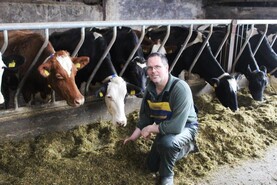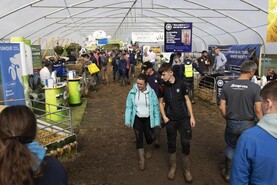You might imagine that after decades of looking after sheep I’d be well used to dealing with the highs and lows of managing a breeding flock. And up to a certain point that observation would be true.
However, in the past few weeks I’ve had an appalling run of ewe deaths, and after a few years of lower than average mortality, it serves as a timely reminder that complacency has no part to play in the world of sheep farming.
As disasters go (everyone loves a good catastrophe – as long as it involves somebody else) January was particularly bad, with the full menu of excuses for ewes to die.
We’re not talking here about the Tuesday night early bird menu; this is the full-blown a la carte range of options.
I’ve had a few elderly animals that melted away due to being kept past their sell-by date, but more annoyingly I’ve had lovely ewes (scanned for triplets) that have just dropped dead (twice) and another triplet-bearing ewe that got on her back and lasted no time at all.
It’s those unforeseen bereavements that are the worst
Even worse, she was in a field beside the yard so there’s that nagging voice at the back of my mind telling me it’s completely my fault.
Prolapsed intestines also featured in the side dishes, and among the desserts was a ewe that developed some sort of stiffness in her joints and despite strong antibiotics and anti-inflammatory injections she had to be put down.
It’s those unforeseen bereavements that are the worst; when some senior citizen of a ram that has been tottering around finally collapses over his Zimmer frame, there just isn’t any issue, but a big, healthy breeding ewe with a bellyful of potential lambs; that’s a different matter.
Avoid
To make things worse, I recently started to do something that all shepherds should studiously avoid.
Because I am now benchmarking the sheep flock in two directions (through CAFRE and due to involvement with a Supermarket contract), I reckoned it would be hugely beneficial to keep a notebook in the pickup and record every animal that died, as well as writing down the date.
If a neighbour asks you how many sheep you’ve lost in the last few months, you want to look them straight in the eye and say: “Maybe two or three.”
This was so that an accurate entry could be made in the monthly numbers column and would avoid the need for fictitious guesswork and a sudden outbreak of a mysterious illness in the last few weeks of the recording calendar that claimed the lives of countless ewes.
Under no circumstances should any shepherd embark upon this pointless exercise.
If a neighbour asks you how many sheep you’ve lost in the last few months, you want to look them straight in the eye and say: “Maybe two or three.”
This innocuous statement isn’t a lie, it’s what you recall.
However, when you write the numbers in a wee red book, there is nowhere to hide. Believe me, it is depressing and disheartening in equal measure.
Scanning
Of course the opposite of death is birth, and final scanning results are ideal for the management system on this farm.
A total of 210 ewes were checked (not including 50 ewe lambs) and have averaged 187%, including four empty ones.
When someone tells me they’ve scanned miles over two lambs per ewe, I feel like shaking hands with them and offering my heartfelt commiserations
Assuming lambing follows the same pattern as other years, actual figures will be about 5% or 6% higher than recorded figures, and somewhere shy of 200% is where I want to be.
I hear people chatting about 220% and they mention it as if it’s something to be proud of.
Maybe I’m getting a bit long in the tooth, but when someone tells me they’ve scanned miles over two lambs per ewe, I feel like shaking hands with them and offering my heartfelt commiserations.
Condition
Due to the non-appearance of wintertime until late January, most of these sheep are in excellent body condition, and it looks increasingly likely they won’t need housed until 10 days or so before lambing.
In addition, daily management (ie shooting across the field on the quad) has been a complete pleasure, with welly boots not necessarily required.
It is years and years since I remember this type of winter, and it helps to remind me just how rewarding farming can be when the weather is on our side.
Read more
Farmer Writes: getting to grips with Making Tax Digital
Farmer Writes: livestock puts silage analysis to the test
You might imagine that after decades of looking after sheep I’d be well used to dealing with the highs and lows of managing a breeding flock. And up to a certain point that observation would be true.
However, in the past few weeks I’ve had an appalling run of ewe deaths, and after a few years of lower than average mortality, it serves as a timely reminder that complacency has no part to play in the world of sheep farming.
As disasters go (everyone loves a good catastrophe – as long as it involves somebody else) January was particularly bad, with the full menu of excuses for ewes to die.
We’re not talking here about the Tuesday night early bird menu; this is the full-blown a la carte range of options.
I’ve had a few elderly animals that melted away due to being kept past their sell-by date, but more annoyingly I’ve had lovely ewes (scanned for triplets) that have just dropped dead (twice) and another triplet-bearing ewe that got on her back and lasted no time at all.
It’s those unforeseen bereavements that are the worst
Even worse, she was in a field beside the yard so there’s that nagging voice at the back of my mind telling me it’s completely my fault.
Prolapsed intestines also featured in the side dishes, and among the desserts was a ewe that developed some sort of stiffness in her joints and despite strong antibiotics and anti-inflammatory injections she had to be put down.
It’s those unforeseen bereavements that are the worst; when some senior citizen of a ram that has been tottering around finally collapses over his Zimmer frame, there just isn’t any issue, but a big, healthy breeding ewe with a bellyful of potential lambs; that’s a different matter.
Avoid
To make things worse, I recently started to do something that all shepherds should studiously avoid.
Because I am now benchmarking the sheep flock in two directions (through CAFRE and due to involvement with a Supermarket contract), I reckoned it would be hugely beneficial to keep a notebook in the pickup and record every animal that died, as well as writing down the date.
If a neighbour asks you how many sheep you’ve lost in the last few months, you want to look them straight in the eye and say: “Maybe two or three.”
This was so that an accurate entry could be made in the monthly numbers column and would avoid the need for fictitious guesswork and a sudden outbreak of a mysterious illness in the last few weeks of the recording calendar that claimed the lives of countless ewes.
Under no circumstances should any shepherd embark upon this pointless exercise.
If a neighbour asks you how many sheep you’ve lost in the last few months, you want to look them straight in the eye and say: “Maybe two or three.”
This innocuous statement isn’t a lie, it’s what you recall.
However, when you write the numbers in a wee red book, there is nowhere to hide. Believe me, it is depressing and disheartening in equal measure.
Scanning
Of course the opposite of death is birth, and final scanning results are ideal for the management system on this farm.
A total of 210 ewes were checked (not including 50 ewe lambs) and have averaged 187%, including four empty ones.
When someone tells me they’ve scanned miles over two lambs per ewe, I feel like shaking hands with them and offering my heartfelt commiserations
Assuming lambing follows the same pattern as other years, actual figures will be about 5% or 6% higher than recorded figures, and somewhere shy of 200% is where I want to be.
I hear people chatting about 220% and they mention it as if it’s something to be proud of.
Maybe I’m getting a bit long in the tooth, but when someone tells me they’ve scanned miles over two lambs per ewe, I feel like shaking hands with them and offering my heartfelt commiserations.
Condition
Due to the non-appearance of wintertime until late January, most of these sheep are in excellent body condition, and it looks increasingly likely they won’t need housed until 10 days or so before lambing.
In addition, daily management (ie shooting across the field on the quad) has been a complete pleasure, with welly boots not necessarily required.
It is years and years since I remember this type of winter, and it helps to remind me just how rewarding farming can be when the weather is on our side.
Read more
Farmer Writes: getting to grips with Making Tax Digital
Farmer Writes: livestock puts silage analysis to the test






 This is a subscriber-only article
This is a subscriber-only article










SHARING OPTIONS: